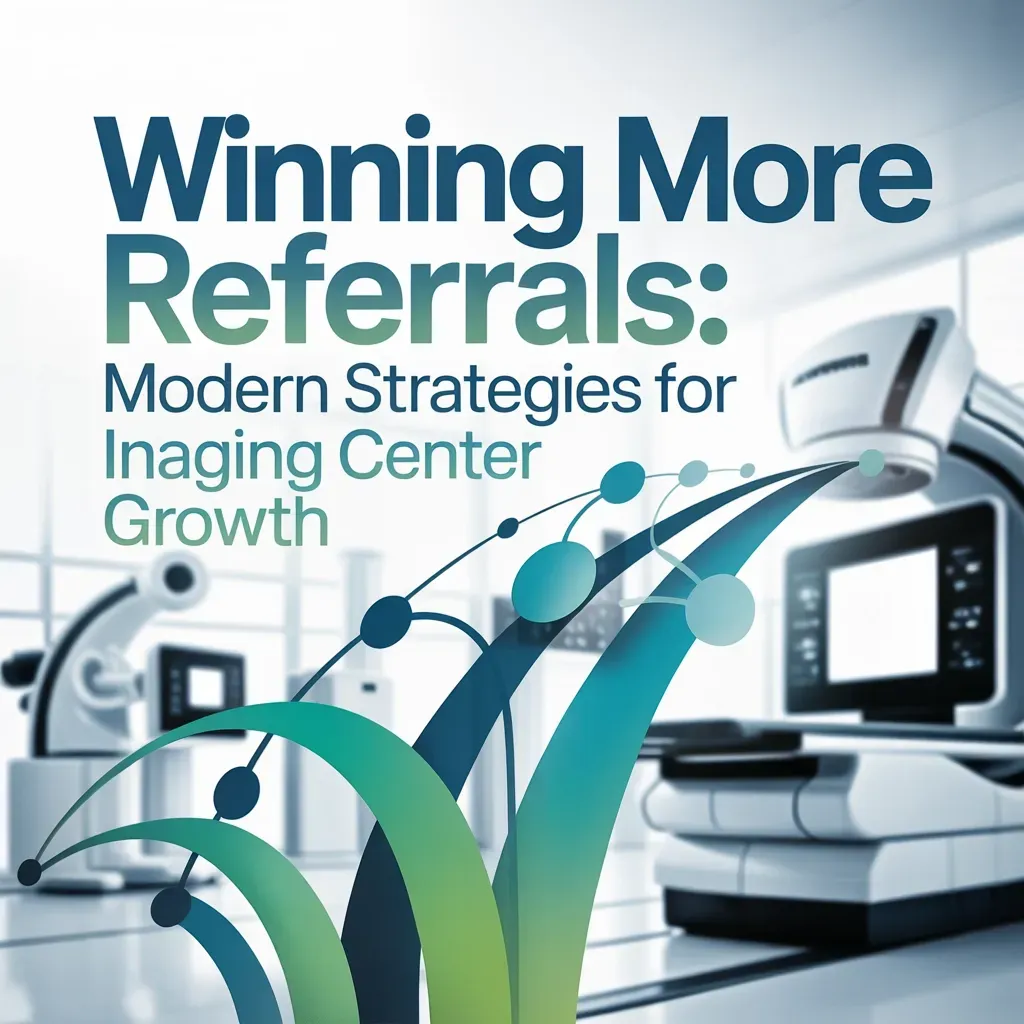
Modern Strategies for Imaging Center Growth to Win More Referrals
In today's competitive healthcare landscape, growing your imaging center isn't just about having the latest equipment or the most experienced radiologists. The lifeblood of any successful diagnostic imaging facility is a robust referral network. With referring physicians having more options than ever before, imaging centers must implement strategic approaches to not only attract new referral sources but also strengthen existing relationships.
"In our experience working with hundreds of imaging centers nationwide, those that implement intentional referral strategies consistently outperform their competitors by 30-40% in annual growth," says Dr. Michael Stein, Medical Director at Metropolitan Imaging Associates.
This comprehensive guide explores proven, modern strategies that can help your imaging center win more referrals and drive sustainable growth in today's dynamic healthcare environment.
The Evolving Referral Landscape
Before diving into specific strategies, it's important to understand how the referral landscape has changed. Traditionally, imaging centers relied heavily on personal relationships between radiologists and referring physicians. While these relationships remain crucial, several factors have transformed the referral ecosystem:
Healthcare consolidation has centralized referral decision-making
Value-based care initiatives have heightened the focus on quality metrics
Patients have become more involved in care decisions
Digital technologies have created new channels for referral generation
Competitive pressures have intensified as imaging options proliferate
These shifts require imaging centers to adopt more sophisticated, multi-faceted approaches to referral development. Let's explore the most effective strategies.
Cultivating Strong Physician Relationships
Despite technological advances, the foundation of referral growth remains building and maintaining strong relationships with referring physicians and their staff.
Implement a Dedicated Physician Liaison Program
A physician liaison serves as the bridge between your imaging center and potential referral sources. This dedicated team member visits practices, educates providers about your services, and addresses any concerns that might impede referrals.
Effective physician liaisons:
Schedule regular visits to high-priority practices
Share updates about new equipment, protocols, or radiologists
Gather feedback about referral experiences
Address issues promptly and personally
Track referral patterns to identify opportunities
According to a study published in the Journal of the American College of Radiology, imaging centers with active physician liaison programs saw a 22% increase in referral volume compared to those without such programs.
Host Educational Opportunities
Position your imaging center as a valuable resource by offering educational sessions for referring physicians and their staff.
Lunch and Learn Sessions: These informal gatherings allow you to share information about new imaging techniques, appropriate ordering guidelines, or radiation dose reduction protocols while building personal connections.
CME Events: Offering continuing medical education credits attracts physicians while demonstrating your commitment to advancing medical knowledge.
Specialized Workshops: Conduct sessions focused on specific areas of interest, such as sports medicine imaging or advanced neuroimaging applications.

Streamline the Referral Process
Nothing damages referral relationships faster than cumbersome processes that create friction for referring offices.
Implement user-friendly online referral portals
Accept multiple referral methods (fax, phone, electronic)
Minimize paperwork requirements
Offer priority scheduling for certain referral sources
Provide rapid report turnaround times with preliminary results available immediately
Ensure easy access to images and reports through secure portals
By removing obstacles from the referral process, you make it easier for physicians to choose your facility over competitors.
Leveraging Digital Marketing for Referral Growth
While traditional relationship-building remains essential, digital strategies have become increasingly important for referral development.
Optimize Your Web Presence for Referring Physicians
Your website should serve as a powerful referral generation tool by:
Creating a dedicated "For Physicians" section with referral information
Highlighting your radiologists' subspecialty expertise
Showcasing advanced equipment and unique capabilities
Providing easy access to ordering guides and protocols
Featuring case studies demonstrating clinical excellence
Including testimonials from satisfied referring physicians
According to our research at Imaging Media Group, imaging centers that optimize their websites specifically for referring physicians see up to 15% more online referrals compared to those with generic websites.
Content Marketing for Referral Development
Strategic content marketing establishes your imaging center as a thought leader while subtly encouraging referrals.
Lead Magnets: Create valuable downloadable resources such as appropriate imaging guides, radiation dose reference charts, or patient preparation instructions. These resources not only provide value but also capture contact information for follow-up.
Email Campaigns: Develop targeted email sequences for different referring specialties, sharing relevant imaging updates, case studies, and practice news.
Video Content: Produce short videos showcasing new technologies, explaining complex procedures, or introducing radiologists. Video content is particularly effective for demonstrating the patient experience.
As noted in our video marketing guide, centers that incorporate video into their marketing strategy experience 34% higher engagement rates with referring providers.

Implementing Technology Solutions for Referral Management
Modern referral growth requires sophisticated technology solutions that track, analyze, and optimize the referral process.
Customer Relationship Management (CRM) Systems
A dedicated healthcare CRM system like Sales Pilot CRM allows imaging centers to:
Track referral patterns by physician, practice, and specialty
Identify high-potential referring physicians
Document outreach activities and follow-ups
Analyze referral trends over time
Measure the ROI of referral development initiatives
Automate personalized communication with referral sources
"Implementing a dedicated referral CRM increased our referral volume by 28% in the first year alone by helping us identify and address referral leakage we didn't even know existed," says Sarah Johnson, CEO of Regional Imaging Partners.
Integrated Referral Management Platforms
Beyond basic CRM functionality, comprehensive referral management platforms integrate with electronic health records and practice management systems to create a seamless referral ecosystem.
These platforms typically offer:
Electronic order entry with decision support
Automated insurance verification
Two-way communication between referring offices and imaging center
Automated patient appointment reminders
Real-time status updates for referring providers
Analytics dashboards for referral tracking
By reducing administrative burden while improving visibility, these integrated platforms make referring to your imaging center the path of least resistance for busy physician practices.
Creating Exceptional Experiences for Referring Physicians
In a competitive market, the experience you provide to referring physicians can significantly impact referral decisions.
Prioritize Communication Excellence
Clear, timely communication is consistently cited as a top factor in referral decisions. Implement the following communication best practices:
Provide direct access to radiologists for consultation
Establish protocols for urgent findings communication
Send personalized follow-up on complex cases
Create standardized report templates with referring provider input
Offer preliminary results via secure text or portal notifications
Implement automated patient engagement systems that keep referring offices informed
Solicit and Act on Feedback
Regularly gathering and responding to feedback demonstrates your commitment to continuous improvement:
Conduct annual satisfaction surveys with referring providers
Establish a referring physician advisory board
Hold quarterly review meetings with top referral sources
Create a dedicated channel for referrer concerns or suggestions
Share improvements made in response to feedback
Studies consistently show that physicians are more likely to increase referrals to facilities that actively seek and implement their feedback.

Community Engagement and Networking Strategies
Beyond direct physician outreach, broader community engagement can significantly impact referral patterns.
Strategic Sponsorships and Events
Targeted sponsorships position your imaging center in front of potential referral sources:
Sponsor local medical society meetings and events
Support specialty-specific conferences in your region
Host open house events showcasing new technology
Participate in healthcare-focused community events
Offer facility tours for referring office staff
Collaborative Care Initiatives
Participating in collaborative care programs demonstrates your commitment to quality while building referral relationships:
Join accountable care organizations in your area
Participate in clinical integration networks
Collaborate on quality improvement initiatives
Partner on research projects with referring specialists
Engage in community health education programs
These collaborative efforts not only generate referrals but also position your imaging center as an essential community healthcare resource.
Measuring and Optimizing Referral Performance
Sustainable referral growth requires ongoing measurement and optimization.
Key Performance Indicators for Referral Growth
Track these essential metrics to gauge referral program effectiveness:
Total referral volume by source, specialty, and geography
Referral growth rate month-over-month and year-over-year
Referral conversion rate (scheduled appointments vs. total referrals)
Referral leakage percentage
Cost per acquired referral
Lifetime value of different referral sources
Referrer satisfaction scores
Data-Driven Optimization Strategies
Use your referral data to continuously refine your approach:
Identify high-potential referring physicians based on specialty and location
Target outreach to physicians with declining referral patterns
Analyze rejected referrals to address underlying issues
Benchmark performance against industry standards
Reallocate resources to the most productive referral channels
Develop targeted interventions for specific referral challenges
As discussed in our comprehensive guide to diagnostic imaging marketing, centers that implement data-driven referral strategies consistently outperform those relying on intuition alone.
Additional Growth Opportunities: Upselling and Service Expansion
While building your referral network, don't overlook opportunities to increase value from existing referral sources through strategic upselling:
Educate referring physicians about complementary studies
Develop protocols for comprehensive diagnostic pathways
Create convenient multi-modality packages for specific conditions
Implement structured follow-up recommendations
Explore new service lines based on referrer feedback
Conclusion: Building a Sustainable Referral Growth Strategy
Winning more referrals for your imaging center requires a multifaceted approach that combines relationship building with strategic technology implementation and exceptional service delivery. The most successful imaging centers recognize that referral development is not a one-time campaign but an ongoing, evolving program that touches every aspect of operations.
Key takeaways for implementing a successful referral growth strategy:
Invest in dedicated referral development personnel
Leverage technology to streamline the referral process and track performance
Create exceptional experiences for both referring physicians and their patients
Develop targeted marketing initiatives for different referral segments
Continuously measure, analyze, and optimize referral patterns
Engage with the broader healthcare community
Solicit and act on referrer feedback
By implementing these strategies, your imaging center can build a robust, diverse referral network that drives sustainable growth even in competitive markets.
Ready to transform your imaging center's referral development program? Contact Imaging Media Group today for a personalized consultation on implementing these strategies in your facility. Our team of healthcare marketing experts specializes in helping imaging centers develop and execute comprehensive referral growth plans that deliver measurable results.
Still have questions? Want to see how we can help you achieve success? Reach out.
Use the form to the right to reach out to us and speak with a representative, and learn how you can grow your Imaging Center.
Let's Chat
Contact Us
© 2025 Imaging Media Group - All Rights Reserved
Imaging Media Group and SalesPilot CRM are divisions of Mixed Media Ventures

